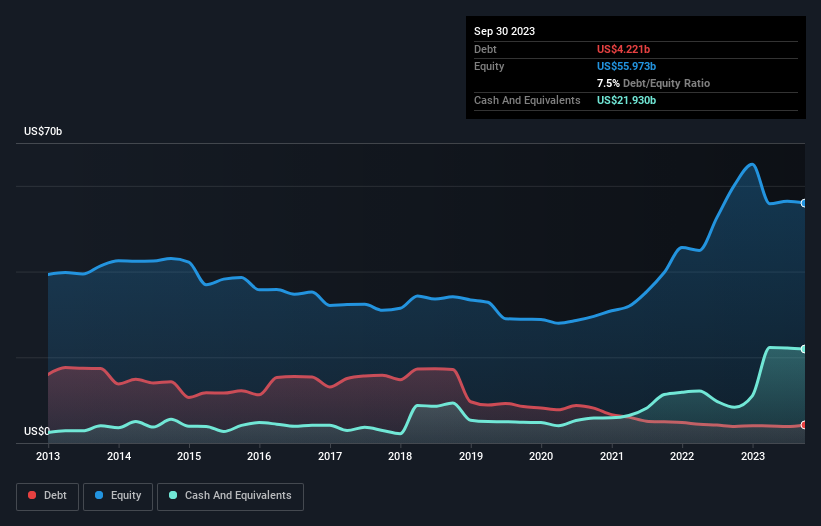Some say volatility, rather than debt, is the best way to think about risk as an investor, but Warren Buffett famously said that 'Volatility is far from synonymous with risk.' So it might be obvious that you need to consider debt, when you think about how risky any given stock is, because too much debt can sink a company. We note that A.P. Møller - Mærsk A/S (CPH:MAERSK B) does have debt on its balance sheet. But the more important question is: how much risk is that debt creating?
When Is Debt Dangerous?
Debt assists a business until the business has trouble paying it off, either with new capital or with free cash flow. Ultimately, if the company can't fulfill its legal obligations to repay debt, shareholders could walk away with nothing. However, a more frequent (but still costly) occurrence is where a company must issue shares at bargain-basement prices, permanently diluting shareholders, just to shore up its balance sheet. Of course, plenty of companies use debt to fund growth, without any negative consequences. The first step when considering a company's debt levels is to consider its cash and debt together.
Check out our latest analysis for A.P. Møller - Mærsk
How Much Debt Does A.P. Møller - Mærsk Carry?
You can click the graphic below for the historical numbers, but it shows that as of September 2023 A.P. Møller - Mærsk had US$4.22b of debt, an increase on US$3.85b, over one year. But it also has US$21.9b in cash to offset that, meaning it has US$17.7b net cash.

How Healthy Is A.P. Møller - Mærsk's Balance Sheet?
We can see from the most recent balance sheet that A.P. Møller - Mærsk had liabilities of US$12.8b falling due within a year, and liabilities of US$14.7b due beyond that. Offsetting these obligations, it had cash of US$21.9b as well as receivables valued at US$8.18b due within 12 months. So it actually has US$2.62b more liquid assets than total liabilities.
This short term liquidity is a sign that A.P. Møller - Mærsk could probably pay off its debt with ease, as its balance sheet is far from stretched. Simply put, the fact that A.P. Møller - Mærsk has more cash than debt is arguably a good indication that it can manage its debt safely.
In fact A.P. Møller - Mærsk's saving grace is its low debt levels, because its EBIT has tanked 72% in the last twelve months. Falling earnings (if the trend continues) could eventually make even modest debt quite risky. There's no doubt that we learn most about debt from the balance sheet. But it is future earnings, more than anything, that will determine A.P. Møller - Mærsk's ability to maintain a healthy balance sheet going forward. So if you want to see what the professionals think, you might find this free report on analyst profit forecasts to be interesting.
But our final consideration is also important, because a company cannot pay debt with paper profits; it needs cold hard cash. While A.P. Møller - Mærsk has net cash on its balance sheet, it's still worth taking a look at its ability to convert earnings before interest and tax (EBIT) to free cash flow, to help us understand how quickly it is building (or eroding) that cash balance. Over the last three years, A.P. Møller - Mærsk actually produced more free cash flow than EBIT. There's nothing better than incoming cash when it comes to staying in your lenders' good graces.
Summing Up
While it is always sensible to investigate a company's debt, in this case A.P. Møller - Mærsk has US$17.7b in net cash and a decent-looking balance sheet. The cherry on top was that in converted 106% of that EBIT to free cash flow, bringing in US$14b. So we are not troubled with A.P. Møller - Mærsk's debt use. The balance sheet is clearly the area to focus on when you are analysing debt. However, not all investment risk resides within the balance sheet - far from it. For example, we've discovered 3 warning signs for A.P. Møller - Mærsk (1 makes us a bit uncomfortable!) that you should be aware of before investing here.
At the end of the day, it's often better to focus on companies that are free from net debt. You can access our special list of such companies (all with a track record of profit growth). It's free.
New: Manage All Your Stock Portfolios in One Place
We've created the ultimate portfolio companion for stock investors, and it's free.
• Connect an unlimited number of Portfolios and see your total in one currency
• Be alerted to new Warning Signs or Risks via email or mobile
• Track the Fair Value of your stocks
Have feedback on this article? Concerned about the content? Get in touch with us directly. Alternatively, email editorial-team (at) simplywallst.com.
This article by Simply Wall St is general in nature. We provide commentary based on historical data and analyst forecasts only using an unbiased methodology and our articles are not intended to be financial advice. It does not constitute a recommendation to buy or sell any stock, and does not take account of your objectives, or your financial situation. We aim to bring you long-term focused analysis driven by fundamental data. Note that our analysis may not factor in the latest price-sensitive company announcements or qualitative material. Simply Wall St has no position in any stocks mentioned.
About CPSE:MAERSK B
A.P. Møller - Mærsk
Operates as an integrated logistics company in Denmark and internationally.
Flawless balance sheet established dividend payer.
Similar Companies
Market Insights
Community Narratives



